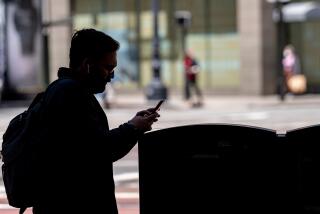More than half of U.S. households have ditched landline phones

- Share via
Reporting from San Francisco — The landline telephone — curly corded, cord-free, rotary or with chunky plastic buttons — used to be a fixture of American homes.
But like most analog technology, it’s rapidly going the way of the dinosaur. More than half of U.S. households — 53.9% — rely entirely on cellphones, according to a survey from the National Center for Health Statistics, an arm of the Centers for Disease Control and Prevention.
The number is remarkable for how rapidly it has increased, according to researchers behind the survey. In 2006, only 15.8% of survey respondents said they didn’t have a landline telephone. The iPhone and its Android counterparts launched the next year, and the rate of landline abandonment has since steadily climbed.
“There are countries in Europe where 80[%] to 90% of households are wireless only, so this trend could continue for some time,” said Stephen J. Blumberg, one of the researchers who compiled the NCHS report.
The survey was conducted in the second half of 2017, and its results were released Wednesday night.
The shift from landline to wireless isn’t surprising, according to telecommunications experts, for a number of reasons: Cellphones can now do more than landline phones; cell service quality and connectivity have become increasingly reliable; and many people who grew up in the age of cellphones and data plans have never even had to use a landline.
“People are cutting the cord on everything,” said Brian Peterson, co-founder of Dialpad and the former head of engineering for Google Voice. “If you’re someone moving into your 20s, and you start to pay bills, the last thing you’re going to do is pay for a landline where someone can only reach you at home.”
There are, of course, some downsides to landline abandonment. Landline phones have historically been more reliable than cellphones, particularly during emergencies. Many landline phones also work during power outages, whereas cellphones require frequent charging.
But cellphones can do things that standard land-line phones cannot, Peterson pointed out.
For example, today’s cellphones and their software give users more control over when and how they can be reached. People can customize their “do not disturb” settings, connect one phone to multiple numbers and dynamically reroute calls depending on who’s calling.
The health statistics center’s survey also found that members of cellphone-only households were more likely to engage in risky behaviors such as smoking, binge drinking, lacking health insurance and driving without seat belts, although the survey did not delve into why that might be.
Ten years ago, cutting a landline was itself considered a riskier behavior, Blumberg said, because having a landline was associated with home ownership, adulthood, settling down and stability. “That’s not the case anymore,” he said.
Twitter: @traceylien







